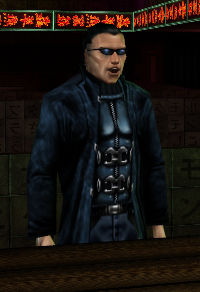The map "Elder" from Quake Live is notable for introducing two new game mechanics:
- Keys and locked doors. The player with the key can open the door while the player(s) without it cannot. Elder only had a silver key and silver key door, but there is also a gold key which functions identically, as well as a "master key" which is designed to open both silver and gold key doors, however neither of these keys were used in any official maps, although the QL workshop probably has a few that utilize them.
- Permanent map change events, which come in two flavors: ones that automatically kicked in after a set period of time, and others that could be triggered by the player via buttons. Doors or platforms would open and never return back to their closed position once they did, so the entire state of the map is irreversibly altered, as opposed to traditional triggers which only temporarily change the state of the map for a short period of time.
From what I remember this map was rather controversial. Was this because of the map design, the game mechanics it introduced, or a combination of both?
In any case this discussion is not about the map Elder. It's about these two game mechanics. They seemed really interesting and yet none of the "modern" arena FPS games which came out after this map, nor CPMA which is still in active development, took any interest in them. I've thought about implementing them in Uber Arena too, though I've mainly been focused on my own mechanics like trampolines.
Keys are like a third type of major item alongside the RA/MH, except instead of granting a higher stack they grant higher map connectivity/mobility. The permanent events add dynamism to the map and allow it to "evolve" over time, forcing changes in tactics as the game progresses.
Notably, these are both map-specific mechanics, so they don't affect the entire game and the maps can be designed to accommodate them. So I don't see why keys and permanent map change events are fundamentally bad ideas. If the map plays bad and it has these two mechanics that should be the fault of the map design, not the mechanics themselves.
- Keys and locked doors. The player with the key can open the door while the player(s) without it cannot. Elder only had a silver key and silver key door, but there is also a gold key which functions identically, as well as a "master key" which is designed to open both silver and gold key doors, however neither of these keys were used in any official maps, although the QL workshop probably has a few that utilize them.
- Permanent map change events, which come in two flavors: ones that automatically kicked in after a set period of time, and others that could be triggered by the player via buttons. Doors or platforms would open and never return back to their closed position once they did, so the entire state of the map is irreversibly altered, as opposed to traditional triggers which only temporarily change the state of the map for a short period of time.
From what I remember this map was rather controversial. Was this because of the map design, the game mechanics it introduced, or a combination of both?
In any case this discussion is not about the map Elder. It's about these two game mechanics. They seemed really interesting and yet none of the "modern" arena FPS games which came out after this map, nor CPMA which is still in active development, took any interest in them. I've thought about implementing them in Uber Arena too, though I've mainly been focused on my own mechanics like trampolines.
Keys are like a third type of major item alongside the RA/MH, except instead of granting a higher stack they grant higher map connectivity/mobility. The permanent events add dynamism to the map and allow it to "evolve" over time, forcing changes in tactics as the game progresses.
Notably, these are both map-specific mechanics, so they don't affect the entire game and the maps can be designed to accommodate them. So I don't see why keys and permanent map change events are fundamentally bad ideas. If the map plays bad and it has these two mechanics that should be the fault of the map design, not the mechanics themselves.
| Mon | Tue | Wed | Thu | Fri | Sat | Sun |
| 1 | ||||||
| 2 | 3 | 4 | 5 | 6 | 7 | 8 |
| 9 | 10 | 11 | 12 | 13 | 14 | 15 |
| 16 | 17 | 18 | 19 | 20 | 21 | 22 |
| 23 | 24 | 25 | 26 | 27 | 28 | 29 |
| 30 | 31 | |||||
Edited by EmeraldTiger at 19:55 CDT, 23 March 2021 - 5041 Hits



